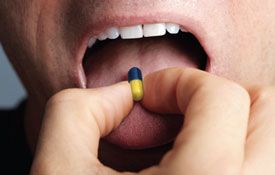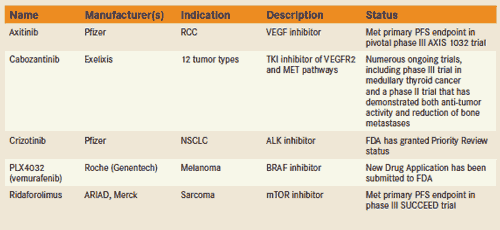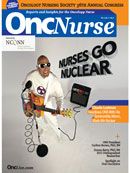Publication
Article
Oncology Nursing News
Spotlight on Oral Oncolytics
Author(s):
Oral oncolytic treatment, a self-administered medication, empowers patients with a level of control over their cancer treatment experience.

Oral oncolytic treatment offers benefits to both patients with cancer and oncology nurses. The self-administered medications empower patients with a level of control over their cancer treatment experience. Patients can conveniently administer oral therapies at home, reducing their time spent traveling to and receiving treatment at infusion centers. The reduction in clinical visits also frees oncology nurses to address their other clinical responsibilities.
Along with these advantages, oral oncolytics present several challenges. With increased patient responsibility and reduced clinical oversight, treatment adherence and side-effect management become major concerns. The high costs of the medications also introduce reimbursement issues.
Patient nonadherence and symptom mismanagement can lead to disease progression, unnecessary treatment changes, and increased toxicities. This creates an additional burden for clinicians with increased appointments and hospital admissions.
With the continued escalation in oral oncolytic use (oral agents represent approximately 25% of the overall oncology research pipeline), oncology nurses must be prepared to facilitate proper use of the treatments. At the ONS 36th Annual Congress, OncLive Nursing discussed oral oncolytics with Susan Moore, RN, MSN, ANP, AOCN.

Susan Moore, RN, MSN, ANP, AOCN, led a clinical practice session on adherence to oral oncolytics at the ONS Congress.
OncLive Nursing: What are the advantages of oral oncolytic treatment compared with infusion therapy?
Moore: Well, for the patient, one of the advantages is that they can take this medicine at home, so they don’t have to schedule an infusion appointment to come in and be treated; they don’t have to [deal with] the…delays in traffic or delays [at] the clinic. They can take their medicine at home. So for some patients, taking oral agents gives them an increased sense of control—a sense that they’re somewhat in charge of their treatment. Now they’re not making decisions about the doses, we hope, and they’re following our instructions on how to take it. But it gives them…a little bit better control than having to be dependent on coming into the infusion center.
Please discuss some of the available evidence of patient nonadherence to oral oncolytic therapy.
The majority of the evidence at this point comes from women with early-stage breast cancer, who have been given, for example, a 5-year regimen of tamoxifen or an aromatase inhibitor that they take after they finish their surgery and any adjuvant chemotherapy that they had to have. And what we’re finding is that women tend to fall off of their therapy, sometimes as early as 2 or 3 years after starting, and so the incidence of nonadherence increases as the woman goes along in that 1-to-5-year range.
And the second is easily—very easily—measured, and that’s in patients who are taking imatinib, or Gleevec, for chronic myelogenous leukemia, or CML. And [for] those patients, it’s relatively easy now to measure their BCR-ABL and see what their level is, and that will more or less tell us if the patient is being adherent with their therapy or not.
So those are some areas where we do have definitive evidence. A lot of the rest of it is anecdotal, that people will say, “Well, my patient says she takes her medicine 90 percent of the time,” but we don’t really have good clinical studies at this point.
"For some patients, taking oral agents gives them an increased sense of control—a sense that they’re somewhat in charge of their treatment."
What are some indicators that a patient may have adherence issues with oral oncolytic treatment?
Patients who tended not to follow instructions during the time of their adjuvant therapy [and] missed appointments. [Also, patients who] have a poor refill rate with their retail pharmacy— and those records are easy to get. If you’re the prescriber, you can call the pharmacy or get online with the pharmacy and find out if patients are refilling their prescriptions on time. So somebody who fails to do those things, or doesn’t call the clinic to tell the nurse or the physician that they’re having a particular side effect—they wait until it’s out of control, or they don’t report it until a visit 2 months later—that’s somebody that I would really want to think twice about putting on a chemotherapy where the side effects or the failure to adhere to the treatment could create some toxicities and problems.
Approved Oral Agents

A sample of FDA-approved oral oncolytics
ALL indicates acute lymphoblastic leukemia; CML, chronic myelogenous leukemia; EGFR, epidermal growth factor receptor; GIST, gastrointestinal stromal tumors; NSCLC, non—small cell lung cancer; RCC, renal cell carcinoma; TKI, tyrosine kinase inhibitor; VEGF, vascular endothelial growth factor.
What are some of the effects of patient nonadherence?
Some of the effects can be non-efficacy, [or] a lowered efficacy. All of the data that we give a patient saying that we believe, let’s say, in early-stage breast cancer that if you complete this regimen of therapy that you have a 98 percent cure rate, well, that’s not based on the patient stopping the medicine after 2 years, or taking it for 6 months, and stopping for 3 months and [then] starting again. It’s based on taking the medicine every day or as it’s ordered for the length of time that it’s ordered. So one of the things that can happen is that we have decreased efficacy.
The second can be if the patient doesn’t take the medicine the way they’re supposed to, we could have increased toxicities. So if someone takes more medicine than they’re supposed to, or they’re afraid to stop taking it when we ask them to hold it for a day or 2 because of a side effect, they can end up in the hospital or can end up with toxicities that are so severe that we actually have to stop the medication because of the toxicity, not because it’s stopped working.
What can oncology nurses do to facilitate patient adherence to oral oncolytic treatment?
Educate, educate, educate. That’s the key, and that’s what nurses are good at. We learned how to educate patients from our very first days in nursing school, and it’s something that we refine over the years. So we don’t want to use a script. We want to use a very individualized approach, tailored to that patient, and hopefully have another family member or a good friend there, because they may hear things a little bit differently than the patient does because of the patient’s anxiety. So that helps us to have a second person in the home or nearby that can help. But basically good patient education, and not just once, but educating the patient every time you have an encounter with them while they’re on this medicine, whether it’s in the clinic [or] over the phone. It takes 2 seconds to ask, “How is it going? Have you missed any medication? If you did miss them, why? And let me help you figure out how to get back on track.” So it’s a quick thing to do. It’s just something we have to do continually.
In the Pipeline

5 oral oncolytics in late-stage clinical development
ALK, anaplastic lymphoma kinase; RCC, renal cell carcinoma; NSCLC, non—small cell lung cancer; PFS progression free survival; TKI, tyrosine kinase inhibitor; VEGF, vascular endothelial growth factor; VEGFR2, vascular endothelial growth factor receptor 2.
What steps are involved with adapting a practice for use of oral oncolytic treatments?
Probably the thing that’s the most difficult is for the physician to release the nurse for time for patient education. In most situations, it’s not a billable event and the physician sees this, especially in a small practice, as this is a nurse who’s spending an hour doing something for which I can’t bill, and she could be instead in the clinic giving an IV infusion, where I could bill for the medication and the nursing time to administer it. So that’s the first hurdle that most, especially small practices, have to get over.
The second is if there is the money in the budget to hire a full-time clinical nurse specialist or nurse practitioner, some type of an advanced-practice nurse, within the practice. This really helps to make sure that education stays on key.
And the other is to help the nurses to be able to do research on adherence, either themselves or to utilize research that’s out there to try to improve their education techniques. In the end, the message I always give to the physician is that the better your nurse is [at educating] the patient, the fewer hospital visits the patient will have, and the fewer phone calls you’ll have to make to try to resolve side effects or try to resolve problems of nonadherence. So it sort of pays you back if you let the nurse do his or her job.










